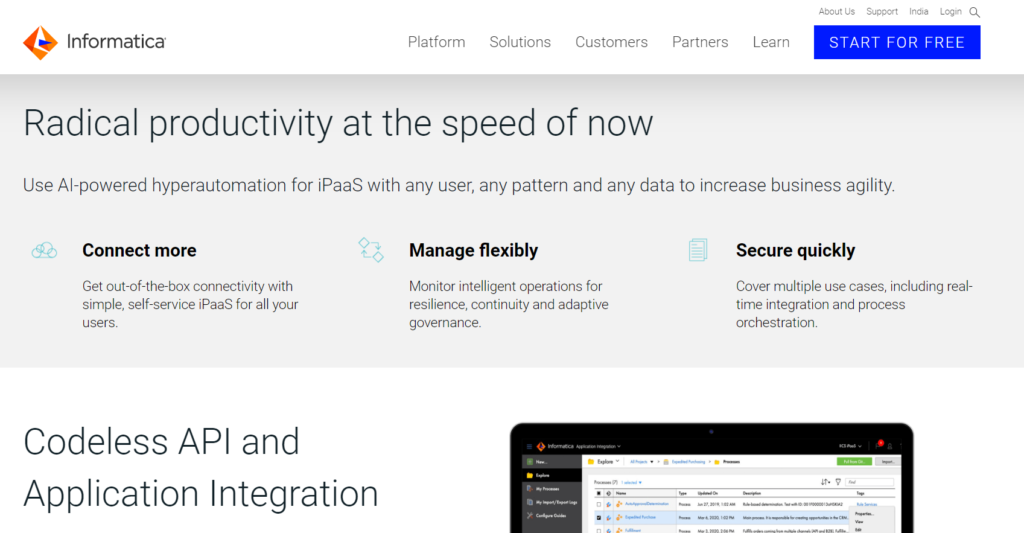Overview Of Informatica And Its Role In Data Integration
Informatica is a data integration tool that helps enterprises manage their data in a more efficient manner. With Informatica, businesses can extract, transform and load (ETL) data from various sources into a centralized repository for analysis. The tool also has features that allow for data quality management, metadata management and master data management.
At its core, Informatica enables organizations to create a single view of their data by integrating disparate systems. This makes it easier to make informed business decisions based on accurate information. With the rise of big data, Informatica has become an essential tool for companies looking to leverage their data assets effectively.
Overall, Informatica plays an important role in the field of enterprise-level digital transformation by enabling companies to streamline their processes and gain valuable insights from their data. As such, it is an invaluable asset for businesses across all industries looking to improve efficiency and drive growth through better decision-making.
Understanding The Informatica Architecture
Informatica architecture is a crucial aspect of the Informatica platform, which is used by organizations for data integration, migration, and management. The architecture of Informatica consists of various components that work together to provide a comprehensive solution for managing data. At its core, the Informatica architecture has three primary components: the client tool, server software, and repository.
The client tool provides an intuitive interface for developers to create and manage workflows for data integration and management. The server software is responsible for executing these workflows on distributed computing resources such as databases or cloud-based systems. The repository stores all metadata related to workflows, transformations, mappings, and other objects created within the platform.

Understanding how these components interact with each other in the context of different deployment models (such as cloud-based or on-premises) is essential to mastering Informatica. Additionally, knowledge of advanced concepts such as load balancing techniques or high availability configurations can help ensure optimal performance while using this powerful platform for enterprise-scale data management tasks.
Informatica PowerCenter Basics
Informatica PowerCenter is a powerful ETL tool that helps organizations extract, transform, and load data from various sources into a centralized data warehouse. It allows for seamless integration of data across different platforms and applications. Informatica PowerCenter is widely used by businesses across the globe to manage their complex data integration needs.
The basic architecture of Informatica PowerCenter comprises several components such as the repository service, integration service, workflow manager, and workflow monitor. The repository service stores metadata information about all objects in the system, while the integration service manages the execution of workflows. The workflow manager is responsible for designing and creating workflows, and finally, the workflow monitor tracks job status and provides monitoring capabilities.
Informatica PowerCenter offers an intuitive graphical user interface that simplifies complex tasks such as mapping transformations between source and destination systems. With its robust features such as support for real-time processing and high scalability options, Informatica PowerCenter has become one of the most popular ETL tools in today’s market.
Data Extraction And Transformation
Data extraction and transformation are two of the most crucial steps in the data integration process. Informatica offers a comprehensive suite of tools that make it easy to extract, transform, and load data from various sources into a target system. With these tools, businesses can ensure that their data is accurate, consistent, and reliable.
The first step in the data extraction process involves identifying and accessing the relevant data sources. This can include databases, file systems, cloud-based applications, social media platforms, and more. Once the sources have been identified, Informatica’s data integration tools can be used to extract this information into a staging area for further processing.

After this initial extraction phase is complete, it’s time to start transforming the data into a format that’s suitable for loading into the target system. This may involve cleaning up missing or corrupt records; merging duplicate entries; standardizing fields such as dates or postal codes; or performing calculations to generate new insights from raw data. By using Informatica’s powerful transformation capabilities in conjunction with its built-in quality controls and error handling mechanisms, businesses can ensure that their extracted data is well-structured and fit for purpose.
Data Loading And Workflow Automation
Data loading and workflow automation are two crucial components of the Informatica tool. Data loading involves importing data from various sources into the Informatica environment, transforming it as per business requirements, and then loading it into target systems. The process can be manual or automated depending on the volume of data being processed.
Workflow automation is a process that automates repetitive tasks within an organization’s processes. In Informatica, workflow automation allows users to automate complex integration workflows by creating reusable workflows and scheduling them to run at pre-set times or in response to specific events.

Mastering Informatica requires a comprehensive understanding of both data loading and workflow automation. With proper training, users can leverage these features to improve data quality, reduce manual errors, increase efficiency, and streamline integration processes across multiple systems within an organization.Take your Career next level with our Ansible Training.
Conclusion
In conclusion, Informatica training equips individuals with the knowledge and skills to effectively utilize the Informatica platform for data integration, transformation, and management. Throughout the training program, participants gain a comprehensive understanding of the Informatica architecture, its various components, and their functionalities.
The training covers essential topics such as data extraction, transformation, and loading, providing hands-on experience in designing mappings, workflows, and sessions. Participants learn advanced techniques for data cleansing, validation, and data quality management, ensuring the accuracy and reliability of the integrated data.
Additionally, the training delves into advanced concepts of Informatica, including parameterization, variable usage, reusable transformations, and performance optimization, enabling participants to develop efficient and scalable data integration solutions.
Informatica Cloud and its integration capabilities are explored, enabling participants to seamlessly integrate data with popular cloud platforms and work with real-time data processing and event-driven architectures.
To Read More Tech Blogs Visit: Technical Nick

















